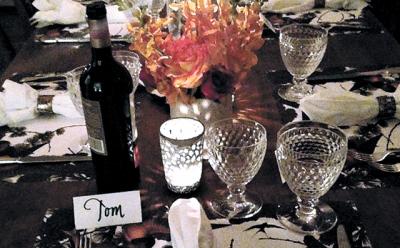Seasons by the Sea: Wine and Dine

Now comes the decision of what to drink with your holiday dinner. Have you decided what you are serving? Roast goose? Prime rib? Another turkey, or heaven forbid . . . tofurkey? How many guests will you have? Do you want to splurge on champagne and wines or have you already blown your budget on Christmas shopping? So many decisions, and then New Year’s Eve is upon us, with more debate over what to serve.
For a holiday open house or a long day of family and friends waiting for the big feast, it’s a good idea to have a cheese board. Start with a good Stilton, the quintessential British Christmas cheese. Granted, this is often the one that has the most left over when the rest of the platter has been decimated, but you can find a lot of uses for it later, such as an escarole salad with beets and toasted walnuts. You should also have a great cheddar, like a Montgomery, a semi-soft white rind cheese like Camembert, a young goat, and a sheep’s milk cheese like an aged manchego. Sweet sherry or port goes beautifully with Stilton, and riesling goes well with most of the other cheeses.
You could serve all young cheeses with wines that are juicy, fruity, and fresh: sparkling wines, crisp whites, dry roses, or reds with good acidity. For older cheeses, try wines with more body. And don’t forget to garnish the plate with plenty of dried apricots, figs, dates, and a bowl full of nuts for cracking.
If you are starting off the meal with a glam first course such as cheese souffle or blinis with caviar, then of course a sparkler like champagne, cava, or prosecco is in order. But a good pinot grigio would be great with cheese souffle as well.
If you are going in a smoked ham or roast pork direction, try an Oregon pinot noir for ham and Chateauneuf du Pape for roast pork. Even chardonnay works with pork if its seasonings are light and herbal. Splurging on prime rib? Enjoy a peppery one with cabernet sauvignon. If you’re putting a mustard rub on it, try syrah.
My Aunt Tink always served a roast goose for Christmas dinner. This is gamier and fattier than turkey, which means it calls for an acidic wine. What are you serving/stuffing it with? If red cabbage and chestnuts, then pinot noir is a good choice. If you’re thinking apples and onions and potatoes then riesling or gewurtztraminer are good matches. For a splurge, try Barolo (sans cabbage) or Barbaresco. For variety (and the young hipsters at your table) try a Belgian beer like Chimay.
Remember Beaujolais nouveau? That thin, watery wine that always came out in time for the holidays? The release date, the third Thursday in November, was a savvy marketing ploy that worked for a while, but the fun frenzy for this gamay grape juice has died down significantly. Half of the production is still consumed in France, the rest is popular in Japan, Germany, and the United States, but sales are a tenth of what they used to be. Thinking this would be an entertaining, retrowine to serve (like brie and Chablis!), I tried a bottle recently and just couldn’t remember what all the fuss was about. Then I remembered that we served it chilled. Well, that didn’t help much. I have decided to give it another chance, try another winery, and risk serving this cheap and cheery wine through the holidays.
As much as I enjoy champagne, it is too expensive. So I like to create original cocktails with cheap champagne, cava, or prosecco. Just as the French put a drop of cassis (black currant liqueur) in champagne to create a Kir Royale, or Framboise (raspberry liqueur) for a Framboise Royale, this year I am going to make use of the beach plum cordial that has been waiting in a dark cabinet since September. It has turned a beautiful hot pink color, which should be quite pretty in a drink. I have also become enamored of an odd drink I learned about from Chimene Macnaughton at Wainscott Main Wine and Spirits. During a recent flurry of sake purchases, she turned me on to a spicy plum sake-based liqueur that is amazing when added judiciously to a glass of sparkling wine. Needless to say, I have no idea what foods to pair with this, but it will be fun trying.
Another beverage possibility is hard cider. It can go with the obvious, like pork and chicken, but is also good with certain cheeses, cream sauces, some risottos, quiche, ham, and crepes.
Now that I have given an oversimplified primer on wine pairing with holiday foods, allow me to confuse you. You don’t necessarily have to choose a wine that complements a food; you can choose one that contrasts with that food. In other words, sometimes you want to play nice and sometimes it’s fun to play rough. For instance, a sauvignon blanc pairs complementarily with a broiled fish with lemon and dill. Try the same wine with a tomato-cream-caper sauce on fish and you have a delightful surprise.
So plan your holiday meal, and then have fun pairing it with a variety of wines or other spirits. There are no right or wrong ways, just different directions.
Click for recipes
